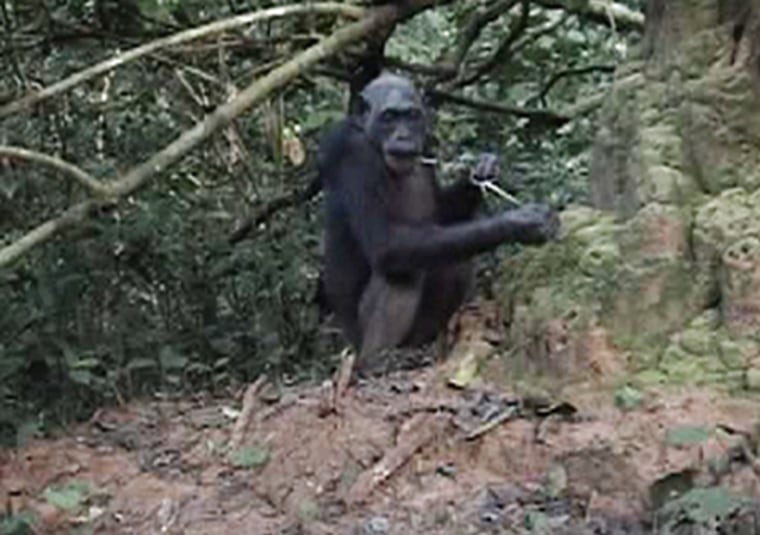"New and improved" could describe a brush-tipped probe invented by wild chimpanzees in Africa that found it did a better job than previous versions of the tool at gathering termites for consumption, according to a new study.
The discovery adds to the growing body of evidence that technological advancements are not limited to human populations.
New Caledonian crows fall under the higher tech heading as well, since they too improved upon an old gadget by adding a hook that, like a fishing lure, can retrieve food from narrow spaces.
The recently identified chimpanzee brush tool, described in the latest Royal Society Journal Biology Letters, requires even more effort to construct.
Co-author Josep Call told Discovery News that chimps first uproot the stem of a plant "or use their teeth to clip the stem at the base and then remove the large leaf from the distal end by clipping it with their teeth before transporting the stem to the termite nest."
At the termite site, "they complete tool manufacture by modifying the end into a 'paint brush' tip by pulling the stem through their teeth, splitting the probe lengthwise by pulling off strands of fiber, or separating the fibers by biting them," added Call, a researcher at the Max Planck Institute for Evolutionary Biology.
Call and colleagues Crickette Sanz and David Morgan observed this construction process while conducting surveillance at termite nests located at Goualougo Triangle, Republic of Congo.
Video recordings of chimp activity around the nests revealed how primates would specifically seek out nearby Marantaceae plants before making the brush tools and then inserting them into nests.
Chimpanzee populations elsewhere are known to do something similar, only with plain-tipped sticks. The scientists determined the brush-tipped tool does a better job, however, since it retrieves more termites.
Call explained that, "termites can bite better the frayed ends since their mandibles get a better grip."
Like pulling forks out of a fondue pot, the chimpanzees can then extract the brush tools and gulp down the attached insects.
Call and his team are not certain how this particular group of chimpanzees devised the more advanced termite fishing probe.
He said, "It could have been chance — a chimpanzee used it by chance and then it caught on."
"So far this is the only place where the brush manufacture has been described as a design feature, and not a by-product," Call added. "Additional research will tell whether this is unique for this study site."
In recent years, scientists have found evidence for other chimp tools, including stone hammers used to crack nuts. Nicknamed "The Chimpanzee Stone Age," primate stone tool use predates the advent of agriculture and may even be a trait that humans also inherited from a common ancestor, theorizes Julio Mercader, a George Washington University anthropologist.
Jane Goodall and her colleagues additionally have discovered that chimpanzees in Gombe utilize a variety of objects -- including stems, twigs, branches, leaves and rocks -- in at least nine different ways while feeding, drinking, cleaning themselves, investigating hard-to-reach objects and even for use as weapons.
Call thinks it's possible still other animals, aside from chimps, birds and humans, make tools and continue to improve upon their design.
He said, "I do not see why other species, if the ecological demands are right, could not invent the use of simple technologies."
